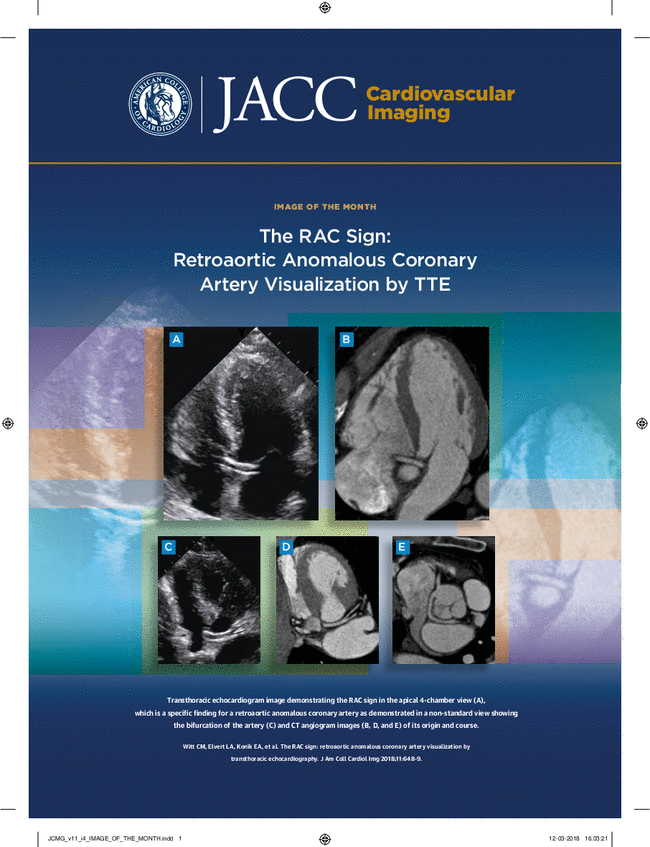Global Practices in Cardiac Imaging for Cardiac Sarcoidosis
IF 12.8
1区 医学
Q1 CARDIAC & CARDIOVASCULAR SYSTEMS
引用次数: 0
Abstract
Background
Cardiac imaging is a cornerstone in the initial diagnosis, management, and follow-up of cardiac sarcoidosis. However, ordering thresholds, access, and follow-up imaging vary across the globe.
Objectives
A Delphi study was conducted to define areas of consensus and areas requiring further study in the use of cardiac imaging in suspected or established cardiac sarcoidosis.
Methods
An international, multidisciplinary panel of experts in cardiac sarcoidosis completed a modified 2-round Delphi study. The study evaluated clinical decision making regarding the use of cardiac imaging, including indication thresholds, interpretation, and interval follow-up imaging. Consensus was defined a priori as ≥70% agreement or disagreement.
Results
A total of 89 experts in cardiac sarcoidosis (89 in round 1 and 75 in round 2) participated, representing 61 centers in 13 countries. Consensus was reached on 22 of 46 items (48%) in round 1 and 21 of 29 items (72%) in round 2. There was a low threshold to order advanced cardiac imaging for new rhythm abnormalities or ventricular dysfunction detected on echocardiography in patients with established extracardiac sarcoidosis. 18F-fluorodeoxyglucose (FDG) positron emission tomography was an important co-primary modality with cardiac magnetic resonance (CMR) for initial diagnosis. If CMR was the first test, there was consensus to proceed to FDG–positron emission tomography after any abnormal CMR result or even after normal CMR result in the setting of moderate or high pretest probability for cardiac sarcoidosis. There was consensus that late gadolinium enhancement quantification was important, but there was no consensus on the threshold of risk or on how best to quantify late gadolinium enhancement. Similarly, reduction in FDG uptake was an important factor in guiding treatment response, but there was no consensus on how to best quantify FDG uptake or what constituted an adequate radiographic response.
Conclusions
Several consensus areas for cardiac imaging in suspected and established cardiac sarcoidosis were identified. This consensus study identified areas of priority for future prospective, controlled, multicenter research studies.
心脏结节病的全球心脏成像实践
背景:心脏影像学是心脏结节病的初步诊断、治疗和随访的基础。然而,在全球范围内,排序阈值、访问和随访成像各不相同。目的进行德尔菲研究,以确定在疑似或已确诊的心脏结节病中使用心脏成像的共识领域和需要进一步研究的领域。方法一个国际、多学科的心脏结节病专家小组完成了一项修改的2轮德尔菲研究。该研究评估了使用心脏成像的临床决策,包括适应症阈值、解释和间隔随访成像。共识被先验地定义为≥70%的同意或不同意。结果共有89名心脏结节病专家(第一轮89名,第二轮75名)参与,代表13个国家的61个中心。在第一轮的46个议题中,有22个(48%)达成了共识;在第二轮的29个议题中,有21个(72%)达成了共识。对于已确诊的心外结节病患者,超声心动图上发现新的心律异常或心室功能障碍时,要求进行高级心脏成像的门槛很低。18f -氟脱氧葡萄糖(FDG)正电子发射断层扫描是心脏磁共振(CMR)初步诊断的重要联合主要方式。如果CMR是第一次检查,在CMR结果异常后,甚至在CMR结果正常后,在心脏结节病中度或高预诊概率的情况下,进行fdg -正电子发射断层扫描是一致的。人们一致认为晚期钆增强量化很重要,但在风险阈值或如何最好地量化晚期钆增强方面没有达成共识。同样,FDG摄取量的减少是指导治疗反应的一个重要因素,但对于如何最好地量化FDG摄取量或什么构成适当的放射学反应尚无共识。结论确定了疑似和已确诊的心脏结节病的几个心脏影像学共识区。这项共识研究确定了未来前瞻性、对照、多中心研究的优先领域。
本文章由计算机程序翻译,如有差异,请以英文原文为准。
求助全文
约1分钟内获得全文
求助全文
来源期刊

JACC. Cardiovascular imaging
CARDIAC & CARDIOVASCULAR SYSTEMS-RADIOLOGY, NUCLEAR MEDICINE & MEDICAL IMAGING
CiteScore
24.90
自引率
5.70%
发文量
330
审稿时长
4-8 weeks
期刊介绍:
JACC: Cardiovascular Imaging, part of the prestigious Journal of the American College of Cardiology (JACC) family, offers readers a comprehensive perspective on all aspects of cardiovascular imaging. This specialist journal covers original clinical research on both non-invasive and invasive imaging techniques, including echocardiography, CT, CMR, nuclear, optical imaging, and cine-angiography.
JACC. Cardiovascular imaging highlights advances in basic science and molecular imaging that are expected to significantly impact clinical practice in the next decade. This influence encompasses improvements in diagnostic performance, enhanced understanding of the pathogenetic basis of diseases, and advancements in therapy.
In addition to cutting-edge research,the content of JACC: Cardiovascular Imaging emphasizes practical aspects for the practicing cardiologist, including advocacy and practice management.The journal also features state-of-the-art reviews, ensuring a well-rounded and insightful resource for professionals in the field of cardiovascular imaging.
 求助内容:
求助内容: 应助结果提醒方式:
应助结果提醒方式:


